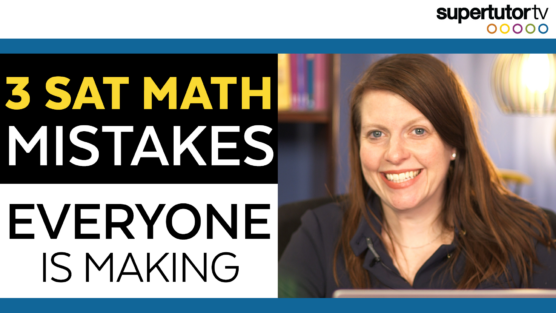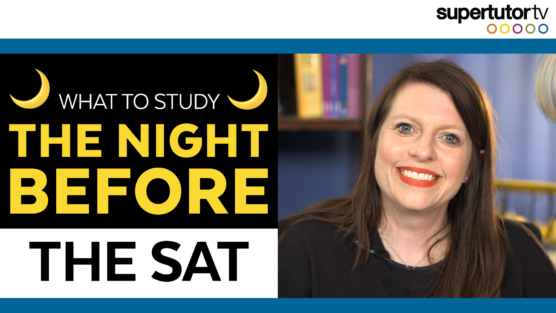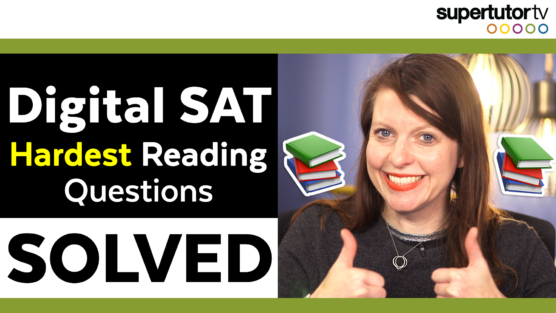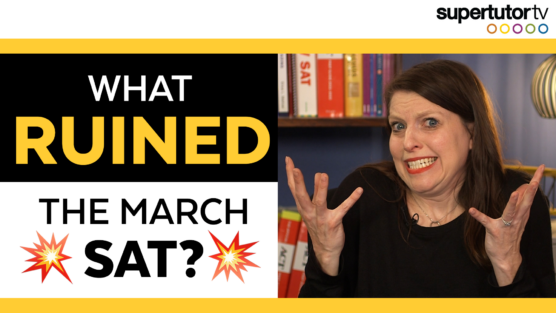Are you taking the digital SAT soon and hoping to totally rock the reading section? If so, in this blog, I’m going to give you some of my quick tips for how to improve your score.
Don’t Cherry-Pick Words You Recognize
Tip number one: don’t cherry-pick words you recognize. For whatever reason, I think many high school students are used to taking multiple-choice tests at school, where the protocol is to prove that you read. The SAT is a totally different test because it’s an open-book test. They’re not trying to prove that you read, and therefore, recall questions are extremely rare on the SAT. Most of the time, you’re asked to analyze. And when you analyze, it’s not just about recognizing things. We’re so used to these types of recognition tests that are meant to prove that you read and that you remember something. That’s not this test at all.
So, what is it instead? It’s a test where you have to understand the ideas and really digest the questions. So what I want you to do is not prefer answer choices just because the specifics match specifics that you know you remember and read. I call that cherry picking. You take a few words, remember that you read those in the passage, see them in the answer choice, and so you choose it. But that’s a total mistake, so don’t do that.
Let’s take a look at an example. So this is a question from the College Board digital SAT database from an Edgar Allen Poe story.
“During a pedestrian trip last summer, through one or two of the river counties of New York, I found myself, as the day declined, somewhat embarrassed about the road I was pursuing. The land undulated very remarkably; and my path, for the last hour, had wound about and about so confusedly, in its effort to keep in the valleys, that I no longer knew in what direction lay the sweet village of B—,where I had determined to stop for the night.”
Which choice best states the main idea of the text?
A. The narrator remembers a trip he took and admits to getting lost.
B. The narrator recalls fond memories of a journey that he took through some beautiful river counties.
C. The narrator describes what he saw during a long trip through a frequently visited location.
D. The narrator explains the difficulties he encountered on a trip and how he overcame them.
So, he does not know where the village where he was going to sleep is. The first answer choice—“The narrator remembers a trip he took and admits to getting lost”—sounds pretty good. This is what I call a paraphrase, because notice that the word “lost” is not in the text at all. That’s what a right answer choice often looks like on the SAT. Get used to paraphrasing. Now we’re going to take a look at a cherry pick. Choice B has “river counties.” But just because you recognize a specific thing, don’t get too hung up on it. My big point here is that just because you recognize a word or two, don’t get hung up on them. Be comfortable with this idea of answering the question with a paraphrase, and you’re going to be in good shape.
Find Keywords
Number two: find keywords. These are things like transitions, contrasts, and comparison words. Keywords are super important on a lot of different kinds of SAT questions in the reading and writing sections. One question type where this comes up that I’m going to focus on today is what we call words and context questions. Those are questions where we’ve got four words to choose from, and you’ve got to put them in the blank. There’s also a similar kind of question called transitions. That’s where the four choices just happen to be transition words, but either way, we’re going to try to look for our keywords, and then we’re going to try to figure out the balance of everything and decode the sentence. I do not just passively read sentences. This is my point to you guys. I do not passively read a sentence and just let the answer flow to me. That’s not how I approach this test; I break it down. I am actively analyzing, pointing out, and calculating, even when it’s not the math section.
“In studying the use of external stimuli to reduce the itching sensation caused by allergic histamine response, Louise Ward and colleagues found that while harmless applications of vibration or warming can provide a temporary distraction, such ________ stimuli actually offer less relief than a stimulus that seems less benign, like a mild electric shock.”
Which choice completes the text with the most logical and precise word or phrase?
A. deceptive
B. innocuous
C. novel
D. impractical
So, “while” on the second line is the first contrast signal, and “such” right before the blank indicates that you’re most likely going to repeat an idea that you’ve already established. But the important thing here is that I’m using the keywords to dissect the text and calculate what the answer should be. Moving on, “less relief” and “than” are where the contrast is coming in. So, I’m breaking it down mechanically. And by doing this, I know I need a word that means harmless. Deceptive, innocuous, novel, and practical are the choices, so the answer here would be innocuous. Obviously, if you don’t have the vocabulary, this is still going to be challenging. But if you know the vocabulary and can break down these keywords and really analyze them, that is going to really help you as you digest these problems.
Find the words that matter the most: your contrast signals, your comparison signals, and all that kind of good stuff.
Take Notes
So my third tip, which kind of parlays off the last tip, is to take notes. And while you do not have an e-pen like I do, you do have tools. There’s a highlighter tool and a strikeout tool on the answer choices, where you can strike out answer choices that you know are wrong. You need to learn all the tools that the College Board offers. You should be downloading the Blue Book app and playing around with those tools before you go in for your test and before you even take practice tests so that you know how to use them and you can apply them. One of the biggest differences between the digital SAT and its predecessor, the paper SAT, is obviously that you’re not on paper, and that makes it harder to write, but writing is one of the key things to do in order to process information well and break things down. So make sure you use your pencil.
The other way you can use your pencil is to take notes on a sheet of paper. It’s not just for the math section, especially when I’m doing quantitative command of evidence questions. Even in that question that I just answered, I want to be writing down my notes and calculating them out, and taking notes is the way I can do that. So, whether it’s on-screen tools or whether it’s the pencil in your pocket, make sure you take notes.
Focus on the Question For Bullet-Point Questions
Tip number four: focus on the question for bullet-point questions. What are bullet-point questions? They’re sometimes called rhetorical strategy questions. About 95% of the time, you can pretty much get it right without reading the bullet points at all. At least so far, with all the examples the College Board has sent. And I hope the College Board changes this question so that’s not true and so you actually have to engage with the text more. I always say verify because there have been a couple questions where you did need to look back, but most of the time you don’t.
The student wants to provide an explanation and an example of Oliveros’s Sonic Meditations. Which choice most effectively uses relevant information from the notes to accomplish this goal?
A. Sonic Meditations is not music but rather a series of sound-based meditations that consist of instructions; Meditation XVIII, for instance, instructs participants to “listen to a sound until you no longer recognize it.”
B. In 1971, Oliveros created Sonic Meditations, a series of meditations that consist of instructions for participants to make, imagine, listen to, or remember sounds.
C. “Walk so silently that the bottoms of your feet become ears” is one example of the instructions found in Oliveros’s Sonic Meditations.
D. While both meditations consist of instructions, Meditation XVIII instructs participants to “listen,” whereas Meditation V instructs participants to “walk.”
So these are my keywords: I need an explanation and an example. I’m looking for those two things. If I have those two things, that’s right. If I don’t, it’s wrong. In A, the second part of the answer is an example, and the first part is an explanation, so this is probably right. Moving onto B, there is an explanation, but I don’t have an example. C, on the other hand, has an example but not an explanation. D is an example of two meditations, but it doesn’t have an explanation. So, A is the right answer, but if I have time at the end after I finish everything else, I’ll come back here, read these bullet points, and make sure that they resonate with the answer.
I hope you guys like this blog and that it was helpful!




